What types of plasterboard are available?
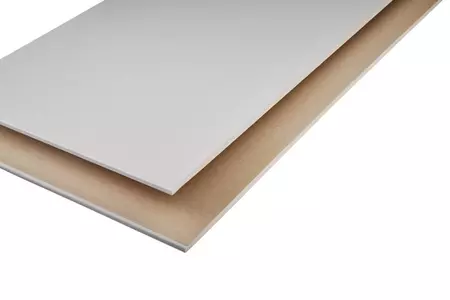
Plasterboard is a versatile building material that allows for easy installation and offers various benefits such as sound and thermal insulation.
There are a wide range of options available. In this article, we will explore the different types of plasterboard available, their features, and applications.
Wallboard
The standard and most basic plasterboard is the Wallboard. The Wallboard comprises of a sheet of plaster enveloped in paper. The paper envelope has two faces, a grey face and a brown face. The grey face is the face to which plaster is applied.
Despite its name Wallboard can also be used for ceilings.
Wallboard comes in a range of thicknesses. The most common thicknesses are 12.5 mm and 9.5 mm.
Plasterboards are generally 2.4 m long and 1.2 m wide.
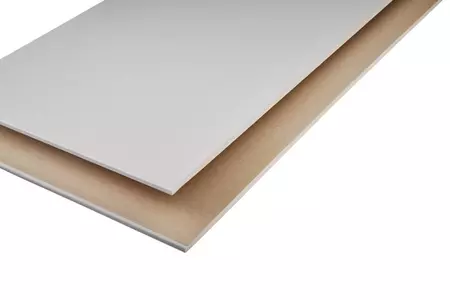
Moisture-Resistant Plasterboard
Moisture-resistant plasterboard has a green paper face, and is therefore also known as 'Green' board. It is designed to withstand high levels of moisture and humidity. It is typically made by treating the gypsum core with additives that resist water absorption.
What are the benefits of using moisture-resistant plasterboard?
- Moisture resistance: Moisture-resistant plasterboard is highly resistant to water damage, making it ideal for areas prone to high humidity, such as bathrooms, kitchens, and basements.
- Mold and mildew prevention: The moisture-resistant properties of this plasterboard help prevent the growth of mold and mildew, ensuring a healthier indoor environment.
- Enhanced durability: With its water-resistant properties, this type of plasterboard offers increased durability and longevity compared to standard plasterboard.
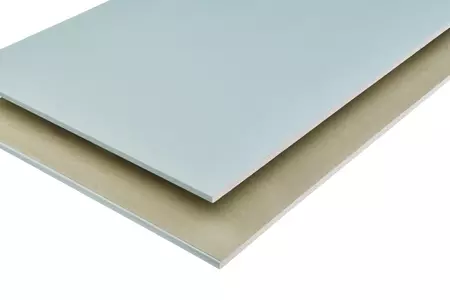
Fire-Resistant Plasterboard
Fire-resistant plasterboard, has a pink paper face and is also known as 'Pink' board. It is designed to provide protection against fire. It contains additives and fibers that enable it to withstand high temperatures for a specified period, providing valuable time for evacuation or fire suppression.
What are the benefits of using fire-resistant plasterboard?
- Fire protection: Fire-resistant plasterboard helps contain the spread of fire and smoke, providing valuable time for safe evacuation and firefighting efforts.
- Compliance with building regulations: The use of fire-resistant plasterboard is often required by building regulations for certain areas, such as stairwells, corridors, and fire escape routes.
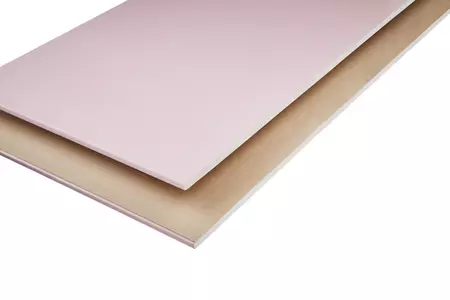
Acoustic Plasterboard
Acoustic plasterboard, also known as soundproof plasterboard (and 'Blue' board), is a specialized type of plasterboard that is designed to reduce noise transmission between spaces. It is made by combining gypsum plaster with dense materials such as glass fibers or insulating materials. The use of these materials adds mass and density to the plasterboard, effectively dampening sound vibrations.
How Does Acoustic Plasterboard Work?
Acoustic plasterboard works by reducing sound transmission through three primary mechanisms: mass, damping, and decoupling.
- Mass: The added mass of dense materials in acoustic plasterboard helps to absorb sound energy and prevent it from passing through. This is particularly effective in reducing low-frequency noise, such as traffic or machinery sounds.
- Damping: The insulating materials within acoustic plasterboard help to dampen sound vibrations, reducing their intensity and preventing them from traveling through the wall or ceiling.
- Decoupling: Acoustic plasterboard can be installed with resilient mountings, which create a gap between the plasterboard and the supporting structure. This decouples the plasterboard from the structure, minimizing sound vibrations that can be transmitted through the building elements.
Installation
Installing acoustic plasterboard is similar to regular plasterboard, but there are some additional considerations to ensure optimal soundproofing. It is essential to follow the manufacturer's guidelines and use the appropriate fixings and jointing treatments.
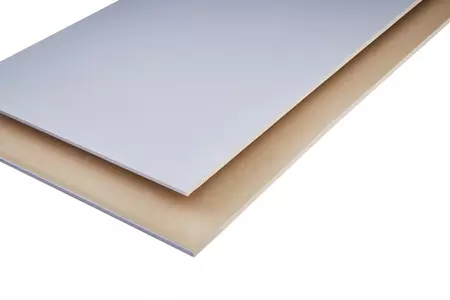
Conclusion
Choosing the right type of plasterboard is essential for achieving optimal results in your construction or renovation project. Whether you need lightweight, moisture-resistant, fire-resistant, or impact-resistant plasterboard, understanding their features and applications will help you make an informed decision. Consider the specific requirements of each area in your home or building and consult with professionals if needed to ensure you select the most appropriate type of plasterboard for your project. With the right plasterboard, you can create beautifully designed, functional, and durable spaces for years to come.
Introduction
If you want to upgrade your home's energy efficiency and create a more comfortable living space, then thermal laminate plasterboards are the solution you've been looking for. These innovative building materials offer a range of benefits, from improved insulation to enhanced soundproofing. In this expert guide, we will explore the advantages, applications, and installation process of thermal laminate plasterboards. Get ready to transform your home into a cozy and energy-efficient haven.
Thermal Laminate Plasterboards
Thermal laminate plasterboards combine the properties of traditional plasterboards with a layer of insulation material, resulting in a single board.
The layer of insulation can be expanded polystyrene (EPS), extruded polystyrene or PIR (polyisocyanurate).
The insulation enhances the thermal performance of the plasterboards by reducing heat transfer through walls, floors, and ceilings.
The Benefits of Thermal Laminate Plasterboards
1. Improved Thermal Insulation
Thermal laminate plasterboards act as a barrier against heat transfer, minimizing energy loss in your home. By reducing heat flow between indoor and outdoor spaces, these boards help maintain comfortable indoor temperatures year-round. This increased insulation saves you money on heating and cooling bills.
2. Soundproofing Properties
Beyond thermal insulation, thermal laminate plasterboards also offer excellent soundproofing capabilities. The insulation layer absorbs sound vibrations, minimizing noise transmission between rooms and reducing external noise infiltration.
3. Versatile Applications
Thermal laminate plasterboards can be used in various applications throughout your home. They are suitable for both new construction projects and renovations. Whether you need to insulate external or internal walls, ceilings, or floors, these boards can be easily installed to improve the thermal and acoustic performance of virtually any space.
Installation Thermal Laminate Plasterboards
Thermal laminate insulation boards can either be screwed to timber studs or applied using adhesive.
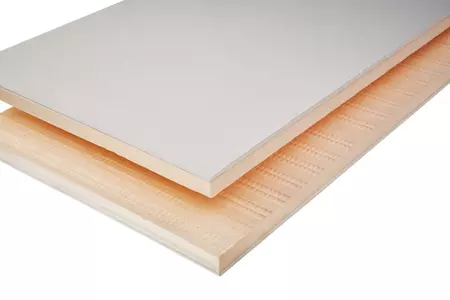
Conclusion
Choosing the right type of plasterboard is essential for achieving optimal results in your project. On a project, Durrant and Daughter will help you choose the most appropriate plasterboard for your application.
Contact Us
Durrant and daughter are a professional and reliable family run plastering business serving Radstock, Midsomer Norton, Bath, Bristol, Shepton Mallet, Frome, and Wells. With years of experience, we take pride in offering top-quality workmanship and ensuring a clean and tidy finish on every project. Contact us today for all your plastering needs.